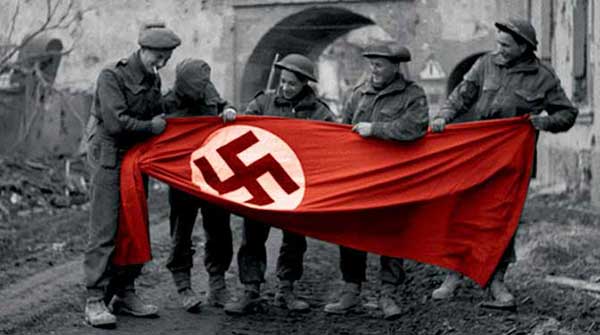 It was a moonless night on January 29, 1944. It was drizzling. Sixteen airmen and two M.I.9 secret agents cautiously descended the steep cliffs near the village of Plouha on the Brittany Coast of France in fear of being caught, executed, or worse, tortured. The enemy patrolled the beach below.
It was a moonless night on January 29, 1944. It was drizzling. Sixteen airmen and two M.I.9 secret agents cautiously descended the steep cliffs near the village of Plouha on the Brittany Coast of France in fear of being caught, executed, or worse, tortured. The enemy patrolled the beach below.
Thanks to Canadian M.I.9 agents Lucien Dumais and Raymond LaBrosse, Operation Bonaparte‘s first successful evacuation of Allied airmen shot down in German-occupied France was underway.
In August of 1942, LaBrosse, a 20-year-old signalman with the Royal Canadian Corps of Signals, was approached by Military Intelligence 9 of the British Secret Service and asked: “Would you be willing to volunteer for secret and highly dangerous work in occupied France, helping allied servicemen on the run?”
He became M.I.9’s first Canadian, French-speaking agent. After being “rushed” through parachute training, LaBrosse, along with fellow agent Val Williams, an emigrant to the United States from Moscow, undertook his first mission, called Oaktree. The difficulties and dangers they encountered made the mission seem doomed from the start.
 He and Williams went through nine harrowing attempts to parachute from a Halifax bomber into France. Finally, on February 28, 1943, they succeeded, landing near the Forest of Rambouillet outside of Paris. LaBrosse’s radio, unfortunately, was damaged in the drop along with his transportation – a bike.
He and Williams went through nine harrowing attempts to parachute from a Halifax bomber into France. Finally, on February 28, 1943, they succeeded, landing near the Forest of Rambouillet outside of Paris. LaBrosse’s radio, unfortunately, was damaged in the drop along with his transportation – a bike.
Williams went ahead to lay out the escape route from Paris to the coast of Brittany. In Brittany, at the home of the Count and Countess de Mauduit, he found 39 airmen evaders holed up. Over 100 others were hiding in the surrounding area.
It was mid-April when LaBrosse, with the aid of a Free French intelligence group, finally managed to make contact with London to order a new radio. Smuggled through Spain, LaBrosse risked his life to pick up the “cumbersome and not very well-disguised set” at the Bordeaux railway station. Unfortunately, after the dangerous train ride with it back to Brittany he discovered that it, too, was defective.
The evacuation of the first party of airmen was put on hold by London. The nights were too short for gunboats to land, retrieve the airmen and escape under cover of darkness. Most importantly, with no dependable communications (that defective radio), too many lives were at stake.
But as the number of hidden airmen in France increased, Williams made his own decision to find a way.
At the end of May, he managed to help about 30 airmen escape the country. But a second evacuation attempt ended with Williams and a number of airmen being arrested while on a train to Pau, headed for Spain.
Within days, the Oaktree mission fell apart. Airmen, along with the Count and Countess, were arrested. One group of airmen was able to escape and they walked barefoot for miles along a railway line to safety.
Meanwhile, the Germans were closing in on LaBrosse, who was unaware that Williams had been arrested. It wasn’t until about June 18 that he found out about Williams’ arrest. It was now his turn to escape, joining the airmen he was there to rescue. He hid from the Germans for weeks, while connecting with 29 airmen who were escaping through Spain. He arrived back in London on September 3 believing that Oaktree was a failure.
It was only later that he learned that about 100 airmen had made it out of France via the remnants of the Oaktree line.
That is when Lucien Dumais entered the picture. Dumais was a 38-year-old weathered and tough sergeant with Canada’s Fusiliers Mont-Royal when he was captured at Dieppe in 1942. He escaped, however, along with three other of his fellow Fusiliers, from a “heavily-guarded” train loaded with prisoners en-route to Germany.
The four went their separate ways, with Dumais hiking across France alone and determined to return to his regiment.
The three others managed to get back to England, where they volunteered to join M.I.9 to help others escape German capture. But when M.I.9 approached Dumais, he declined.
Dumais was angry about the Dieppe raid and the toll it had taken on his fallen comrades. Under a pen name, he wrote to a London newspaper expressing his concern. His identity was discovered and he was sent to North Africa to train with the British First Army. After a relatively dull four months in North Africa, Dumais changed his mind and enlisted in M.I.9, where he was partnered with young LaBrosse.
Equipped with forged identity papers, compasses hidden in buttons and fountain pens containing tear gas, the two made a formidable pair of spies as they worked together in occupied France on “Operation Bonaparte.” They created the Shelburne line of escape using the still intact Paris end of the Oaktree line.
Their adventures unfold like a romantic but fated Bogart movie: they found shelter in a local sugar factory and connected with their assigned contact – a young hairdresser in the rue des Capucines who was arrested the next day. The safe-house she arranged for them was compromised.
From November 1943 through January 1944, LaBrosse and Dumais risked capture daily, their fake papers passing scrutiny each time they were picked up for random interrogations.
The Shelburne line took shape. The plan was to hide the airmen in Paris and, on moonless nights, they would collect them in the village of Plouha where they would scale down a steep cliff while flashlights signalled the gunboats out at sea to send in the rowboats for the airmen. While LaBrosse monitored the radio, Dumais organized the evacuations. They escorted the airmen through road checks and minefields – and didn’t lose one of them – including Val Williams, who had escaped but broke his leg and had to be carried down the steep slopes to safety in a makeshift stretcher.
LaBrosse and Dumais’ Shelburne line saved 307 men. Of those, 135 evacuated through Bonaparte Beach. LaBrosse fought with the Royal 22nd Regiment in the Korean War and retired a Colonel in 1976. Dumais returned to Canada after the war and was part of the 40th Anniversary of D-Day, travelling back to France where he and other veterans dedicated a cairn to Plouha. Both have since passed away, decorated heroes of our country.
Thanks to Roy MacLaren and his book titled Canadians Behind Enemy Lines, 1939-1945 and Silent Heroes, Downed Airmen and the French Underground, written by Sherri Greene Ottis and Veteran’s Affairs Canada’s website and the WWII Escape and Evasion Information Exchange website.
The views, opinions and positions expressed by columnists and contributors are the authors’ alone. They do not inherently or expressly reflect the views, opinions and/or positions of our publication.
© Troy Media
Troy Media is an editorial content provider to media outlets and its own hosted community news outlets across Canada.


